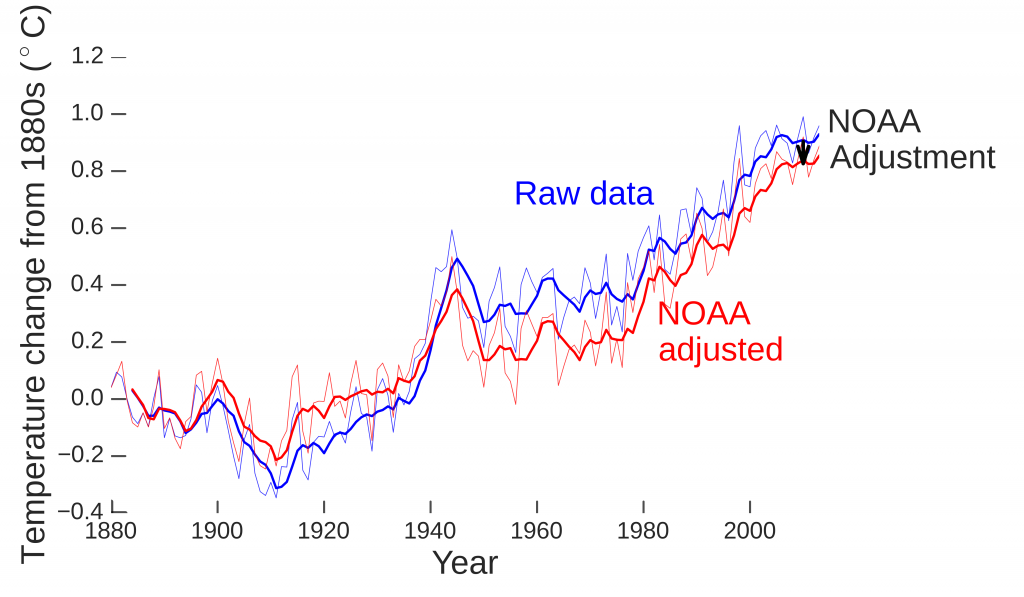
Inadequate support: The article is based on a blog post, but does not explain how well-researched issues with past temperature data should be corrected, if not by the methods scientists currently employ.

REVIEW
CLAIM: [...]NOAA has been cooking the books. Yet again – presumably for reasons more to do with ideology than meteorology – NOAA has adjusted past temperatures to look colder than they were and recent temperatures to look warmer than they were.
Peter Thorne, Professor, Maynooth University:
The central tenet of the claim appears to be that NOAA are nefariously adjusting past temperatures to be colder with the effect of making recent temperatures appear warmer. NOAA do, indeed, adjust historical temperature records, but the process by which they do so can hardly be termed nefarious.
The data are made available on their website as the original data, the quality controlled and the homogenised versions on a station-by-station basis. The methods by which they undertake the analysis are fully documented in several papers in the peer-reviewed literature available from their website. The code they use to determine the adjustments is made available without restriction via their website.
They have participated in a big intercomparison using blind benchmarks of a range of methods1. Their method ranked extremely highly and consistently removed real data issues while having an exceptionally low false detection rate. They followed-up with an in-depth assessment against a range of benchmarks to explicitly assess the performance of the algorithm in the contiguous United States. Both the multi-participant benchmarks and these bespoke benchmarks showed that their method consistently improves the data quality, but also consistently under-estimates the required large-scale adjustment.
So, yes, the NOAA analysis cools the past. No, its not some nefarious black magic, just the opposite in fact. And, perhaps most concerningly, everything we know about the method suggests it is adjusting too little and not too much.
- 1 – Venema et al (2012) Benchmarking homogenization algorithms for monthly data, Climate of the Past
Victor Venema, Scientist, University of Bonn, Germany:
To estimate how much the world has warmed, other changes need to be removed from the observations made at weather stations, observing ships and buoys. For example, if the surrounding of a station becomes more urban this often causes a warming that is local and needs to be removed to estimate the amount the world has truly warmed. Similarly when such a station moves to a better location, which is cooler, such a cooling jump needs to be removed for an accurate warming estimate.
When it comes to the global mean temperature the main effect that needs to be removed is that in the past many sea surface temperature observations were made by hand with buckets and nowadays are made automatically at the water inlet of ships. While the water is hauled on deck and the thermometer adapts to the water temperature, the sea water evaporates and cools. Old measurements are thus 0°C to 0.4°C (0.7°F) too cold.
In the unscientific formulation of Breitbart this means that the adjustments for this effect make the past warmer and the recent temperatures colder. But overall, the estimated global warming actually becomes smaller when taking into account all the adjustments—the opposite of what Breitbart claims. [See figure in Mark Richardson’s comment below.]
The adjustments climatologists make for land station data do make the warming greater. But the ocean adjustments (which reduce the warming trend) are more important for the global average.
How large the adjustments need to be depends on how many other changes there were. The adjustments in the United States of America are relatively large, mainly due to two effects.
In the past the thermometers were read more often in the afternoon, while nowadays they are read more often in the morning. The estimates of the daily average temperature based on minimum and maximum temperature thermometers are a bit colder in the morning than in the afternoon. A particularly cold morning can affect the observed minimum temperature of two days and a very hot afternoon the maximum temperature of two days.
The temperature used to be measured with a thermometer in a Cotton Region Shelters in the USA. Nowadays they are mostly made using an Automatic Weather Station. These Automatic Weather Stations on average measure a lower temperature because they heat up less standing in the sun. The difference is especially large for the maximum temperature and for the summer. Comparing old summer maximum temperature with those of today would not be comparing like with like.
Mark Richardson, Research Associate, Colorado State University/NASA JPL:
Raw data show more global warming since 1880 than is reported by NOAA. This is because NOAA “adjusts” temperature data to fairly compare different measurement times, places, and technologies. The cooling effect of adjustments on global temperatures has been shown lots of times, such as with the graph below for 1880—2013 temperatures.
A small group of conspiracy theorists flip this reality by “cherry picking”, which means using a fraction of the data to prop up claims that are false globally. It’s the sort of technique that would insist that this is a 100% blue cherry tree.
NOAA scientists know that afternoons tend to be warmer than early mornings so it would be dumb to mix, for example, 1940s morning temperature readings with 2010s afternoon readings without accounting for this. They refuse to do obviously, provably dumb things so they carefully correct the data for a fair comparison. In the U.S., thermometers used to be read largely in the afternoon but now tend to be read in the morning1. This means that adjustments in the U.S. are warming, making it a popular choice for hints at conspiracy.
There are ways to judge whether new claims are credible. Firstly, do they mention that global adjustments are cooling overall? Secondly, do they discuss reasons for adjustments including measurement time? If the answer is “no” to either then the author is hiding relevant information or is clueless about the topic and you should be very sceptical.
Fortunately the scientific method can reliably test new claims through submissions to scientific journals for peer review, which tends to filter out obvious dumb mistakes like ignoring how afternoons are warmer than early mornings. Blog posts, think tanks and newspapers have no such filter.
We know that NOAA’s adjustments improve things since they’re tested and updated whenever issues are found. For example, even a blogger who’s hostile to climate science results published a paper confirming that the NOAA U.S. average temperature changes are solid2. Another study by an independent “red team”, partly funded by a Koch foundation, supported NOAA’s conclusions3.
I was involved with a check of NOAA’s ocean record using infrared scans from satellites4. The satellites supported NOAA’s results despite baseless & hysterical accusations that had been thrown at the scientists. After more than a decade of being relentlessly wrong, it’s time to be very careful with any new conspiracy claims aimed at the temperature records.
- 1 – Vose et al (2003) An evaluation of the time of observation bias adjustment in the U.S. Historical Climatology Network, Geophysical Research Letters
- 2 – Fall et al (2011) Analysis of the impacts of station exposure on the U.S. Historical Climatology Network temperatures and temperature trends, Journal of Geophysical Research: Atmospheres
- 3 – Rohde et al (2012) A New Estimate of the Average Earth Surface Land Temperature Spanning 1753 to 2011, Geoinformatics & Geostatistics: An Overview
- 4 – Hausfather et al (2017) Assessing recent warming using instrumentally homogeneous sea surface temperature records, Science Advances



